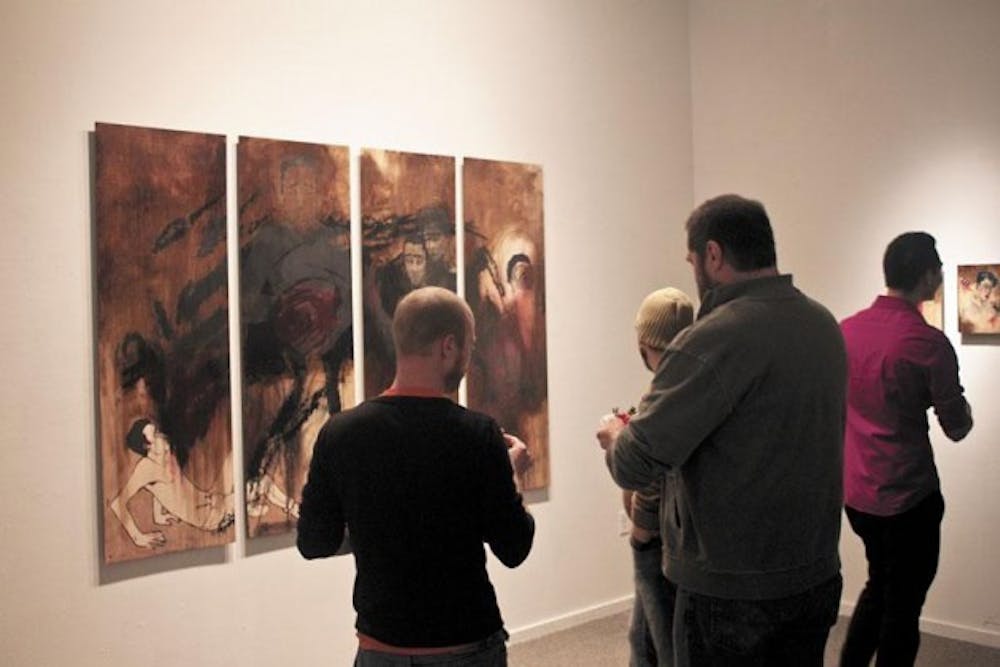It has been said that art can take you places; looking at a well-crafted piece of artwork can lead viewers into imaginative spaces worlds away from their ordinary lives.
The saying isn't just figurative.
For four art students in the Department of Visual Studies, competing for the Rumsey Scholarship has provided the chance to go somewhere with art. The Rumsey Scholarship is an annual award given to two junior art students for summer travel to expand their artistic education and knowledge.
Junior art students Alissa Bailey, Bailey Danahy, Rosemary Williams and Tanya Dorph-Mankey presented their work last Thursday evening in the Basement Gallery of the UB Center For the Arts.
Each of the promising artists offered her own imaginative spaces and artistic perspectives. Their work encompasses vast areas of art making, ranging from printmaking and fabric art to installation art and metalwork.
According to Mark Snyder, a Master of Fine Arts student in the Department of Visual Studies, the work of the four artists appeared unified despite the variance in mediums.
"It's a very nice, [cohesive] show," Snyder said. "The [artists] seem to complement each other very well ... they all have a similar palette. They all have earth tones and muted, quiet colors."
This coherent color scheme in the show is exemplified well by "Spheres," an installation piece by Bailey, who specializes in large-scale installation art.
"Spheres" features several basketball-sized, hollow spheres made of resin; each sphere is suspended in midair with clear wire. The spheres are a brown-amber color that blends with the black holes. The result is an abstract art piece that evokes questions of the artist's own thought process.
The piece is a result of Bailey's musings about the end of the world.
"I was thinking very organically and cellular about the apocalypse," Bailey said. "How [it] can represent the death of things, but also regrowth, rebirth and a new chapter."
A focus on death and the revival of life was also portrayed in the work of Danahy, who incorporated metalwork into her pieces.
Danahy's work combined a multiplicity of materials such as bread, books, wire and silverware to form intriguing three-dimensional artwork. Her most notable piece, "Grains of Animacy," fused metal wire, bread pieces and black paper within the bends and folds of an open book.
The result: a transfigured hardcover book with pointed metal wires jutting out of it in multiple directions. Another notable aspect of the work is the smell, which stemmed from the mold forming on the bread.
Danahy considers her work a portrayal of objects that are slowly becoming obsolete - for this instance, books.
"You can get them online now," Danahy said. "They're starting to decay ... they're starting to rot. It's about books as a dying form."
Dorph-Mankey, another competing artist, merged influences from Japanese anime into her printmaking pieces. Her work consisted of striking, selectively colored portraits printed on wooden panels.
"My Friends Call Me Little Red," one of her prints, illustrated a young man in a hooded sweatshirt dyed in a stark, deep red color with one hand covering his mouth in shyness. The word "LOVE" was tattooed on his fingers.
The overall aesthetic of the work has a likeness to a graphic novel drawing; it captures the young man's most striking facial features in a simplified manner.
"I love working with art about people," Dorph-Mankey said. "With different types of people, you get different types of stories."
Williams also used printmaking techniques for her work but in a much more abstract manner. Her work is devoid of any noticeable subject matter; for Williams, it's mainly her techniques of creating her work that give it meaning.
"When I go into making a piece, I don't have a set idea," Williams said. "During the process of making the piece is when I understand more about what I'm doing. The aesthetic leads to more thought."
Williams' art demonstrated her experimental and process-oriented art practice.
Her work consisted of numerous fabric pieces under the collective title "Collections 1, 2, and 3." Williams' most notable piece in this collection comes in the form of a large-scale fabric piece draped along the height of the gallery wall that flows into the middle of the gallery floor. The majority of the fabric is printed in dark blue, burgundy and purple. The unique texture of the fabric is acquired using objects such as rocks, needles, tacks and rulers; it gives the piece a unique aesthetic based on intricate textures.
As for Williams, her work is a testament to individual experience and our own modes of thinking and seeing.
"It's just the different perspectives of how we can look at things," Williams said.
Submissions for the Rumsey Scholarship will be on display through March 1.
Email: arts@ubspectrum.com





